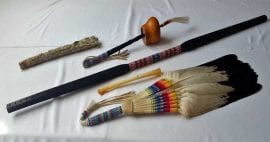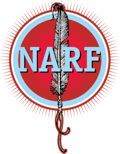STATEMENT OF THE NATIONAL COUNCIL OF NATIVE AMERICAN CHURCHES OPPOSING CHANGES TO THE EXISTING UNITED STATES FISH AND WILDLIFE SERVICE RULES PERTAINING TO THE RELIGIOUS USE OF FEDERALLY PROTECTED BIRD FEATHERS
NARF Attorneys: Steven C. Moore and Natalie Landreth
Presented at the National Congress of American Indians Mid-Year Conference, June 2019
I am Natalie Landreth, a senior attorney for the Native American Rights Fund. I’m speaking today on behalf of the National Council of Native American Churches (National Council or NCNAC), which consists of the Native American Church of North America, the Native American Church of Oklahoma, the Native American Church of South Dakota, and the Azee’ Bee Nahagha of Dine Nation. Collectively, these groups and their member organizations represent hundreds of member chapters, and the vast majority of NAC members throughout the United States and Canada. The Native American Church is the name chosen in the early 1900s for the peyote religion—a traditional inter-tribal religion that dates back to pre-Columbian Texas.

Native American Church members hold very serious beliefs about eagle feathers and parts, as they play an irreplaceable role in NAC ceremonies. NAC ceremonies could not be carried out without eagle feathers, eagle bone whistles, and feather fans. Eagle feathers, and particularly immature golden eagle feathers, are necessary implements for the conduct of a Native American Church ceremony. Without eagle feathers and whistles, the prayers made in Native American Church ceremonies are merely words spoken by human beings. It is with eagle feathers and parts that these words can be transferred to the spiritual realm and received by the Creator. Therefore, without healthy eagle populations and continued access to their feathers and parts, there can be no Native American Church.
On their behalf I’m speaking today in opposition to the proposed rulemaking that would fundamentally alter existing rules pertaining to the religious use of federally protected bird feathers, including eagle feathers; would in turn radically alter the federal government’s operation of its National Eagle Repository; and would propose to ban the criminal prosecution of persons not members of federally recognized tribes, merely if they profess to have sincere religious beliefs requiring their need to possess eagle feathers.
We wish to stress the following points:
- The comment period is not adequate. Even extending the comment deadline from July 1 to July 16 does not permit the National Council organizations adequate time to fully brief their respective memberships and to develop comments that reflect the legal and practical implications of the proposed rulemaking.
- The rush to complete consultation violates the current US Fish & Wildlife Service Native American Policy and the “reserved rights, statutes, treaties, judicial mandates, Executive Orders (E.O.), Presidential proclamations, and Secretary’s Orders” which undergird current federal policy.
- “Sincere religious believers” is an undefined term proposed by Petitioners, and is administratively unworkable for the staff of the National Eagle Repository to utilize in making permit decisions. It is also impossible for law enforcement – state or federal – to utilize. Allowing a potentially exponential increase in the number of people that may possess eagle part without a permit will frustrate law enforcement efforts to investigate poaching.
- There are many people who will disingenuously claim to have “sincere religious beliefs” solely for the purpose of obtaining feathers. There are many people who seek to exploit American Indian religious beliefs. There is a network of new age people who conduct fake ceremonies and have exploited a number of people for the purpose of profit. In addition, just as people fake religious beliefs in order to obtain and use peyote, ayahuasca, or marijuana (a common phenomenon). People will fake religious beliefs so that they can obtain feathers for reasons of profit, curiosity, “playing Indian” at “Pocahontas pageants,” or other disingenuous reasons.
- Law enforcement needs bright-line rules. How would law enforcement gauge an individual’s “sincere religious beliefs”? Similarly, because there is no consistent or accepted definition of “state-recognition” of Indian tribes, membership in a federally recognized tribe is the only objective and bright line test that exists for law enforcement.
- Currently, there are over 4,000 members of federally recognized tribes on the waiting list for approximately 900 eagles the Repository receives each year. Applicants can expect to wait approximately 2 and one half years for an order to be filled for a bald eagle or mature golden eagle, and four to five years for an immature golden eagle. Petitioners have made no estimates regarding how many additional applications the Repository could expect to receive if open to “all sincere religious believers.” At a minimum, if members of state-recognized tribes were allowed, the Repository could expect several thousand more applicants to the waiting list. Even this modest increase will create a nightmare situation for the Repository.
- Adding more people to the waiting list threatens the very ability of Native American Churches and the peyote religion to function. This violates the government’s trust responsibility to members of federally recognized tribes who are practicing NAC members. Moreover, because, unlike “new age” religions, the United States (with the exception of a few chapters in Canada) is the only place where the Native American Church religion is practiced, the preservation and continuation of this religion should be considered a compelling governmental interest.
- Compelling interests in curbing the black market for eagle parts still exists—bald and golden eagle populations remain fragile. The golden eagle in particular has important significance to members of the Native American Church. Unlike bald eagle populations, which have remained stable, the golden eagle population has remained consistently at about 30,000 since the 1960s (when it was first added to the Eagle Act).
Thank you for listening to these remarks. Your highest obligation is to serve the interests of federally recognized tribes to whom you owe a trust responsibility. The proposed rule changes are unenforceable and administratively unworkable.
The National Council of Native American Churches will be providing additional written comments by the July 16 deadline, unless the FWS makes the right decision to extend that deadline again, or pull this action back for further, meaningful consultation.
More blog posts

